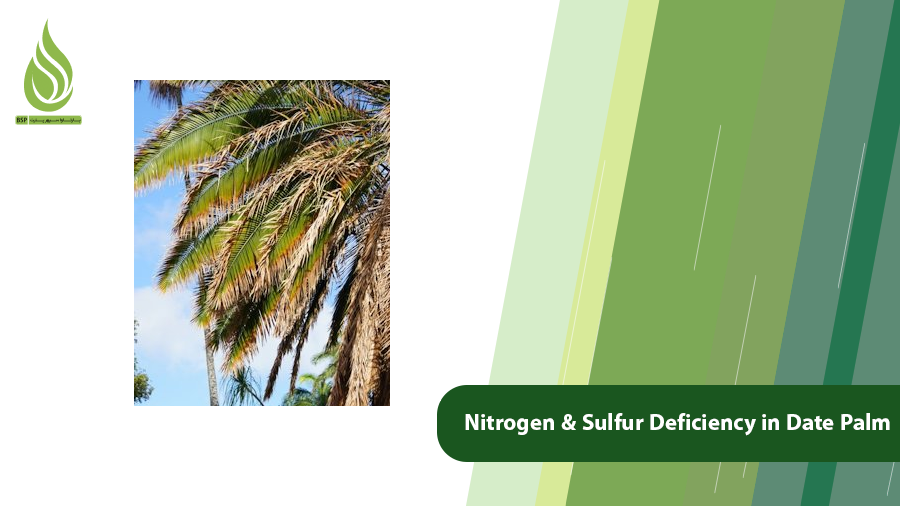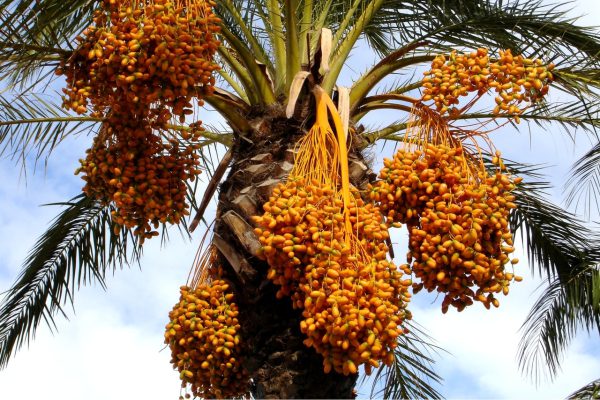
Signs of Nitrogen and Sulfur Deficiency in Date Palm Trees
Nitrogen and sulfur are critical nutrients essential for the growth and development of date palm trees. Deficiency in these elements, especially nitrogen, can lead to reduced fruit yield and quality, while also impairing the uptake of other nutrients. This article explores the symptoms of nitrogen and sulfur deficiency in date palm trees and provides insights into their identification and prevention. Read on to learn more.
Symptoms of Nitrogen Deficiency in Date Palm Trees
Nitrogen is a vital nutrient heavily utilized by date palms. As one of the most used fertilizers, it’s playing a key role in chlorophyll production and the growth of stems and leaves. As a primary component of chlorophyll, nitrogen is indispensable for photosynthesis. A lack of nitrogen reduces chlorophyll synthesis, which in turn stunts tree growth and lowers productivity. Date palm trees suffering from nitrogen deficiency typically appear smaller and weaker compared to healthy trees. Their leaves are often undersized and prone to yellowing.

Nitrogen deficiency also negatively impacts fruit production, resulting in fewer fruits that may lack optimal size, flavor, and quality. Below are common symptoms indicating nitrogen deficiency in date palms:
- Yellowing Leaves: One of the hallmark signs is the yellowing of lower leaves, while upper leaves remain green.
- Stunted Stem Growth: Nitrogen-deficient date palms exhibit slower growth, with stems developing at a reduced pace.
- Small Leaves: Leaves are noticeably smaller than normal, and overall leaf production may decline.
- Reduced Yield: Nitrogen deficiency leads to lower fruit production.
- Premature Fruit Drop: Weakened trees may experience abnormal fruit drop due to incomplete growth.
- Stem Discoloration: A lighter-than-usual stem color can indicate a need for nitrogen-based fertilizers.
Symptoms of Sulfur Deficiency in Date Palms
Sulfur is another essential nutrient critical for plant growth, contributing to the production of proteins and enzymes that support plant metabolism. Sulfur also enhances fruit flavor, weight, and quality. Fruits lacking sufficient sulfur may have diminished taste and nutritional value.

Date palms thrive in hot, arid regions where soils are often alkaline and saline. Applying sulfur in such environments helps lower soil pH, improving nutrient uptake for elements like phosphorus and potassium. Sulfur also boosts the trees’ resilience to soil salinity. You may want to know how ammonium sulfate can affect phosphorus uptake.
A sulfur deficiency in date palms triggers several issues, particularly affecting younger leaves at the branch tips. These leaves often turn uniformly yellow, with discoloration rarely confined between veins. In severe cases, leaves may brown or appear scorched. Other symptoms include:
- Small, Deformed Leaves: Leaves are significantly smaller and may change shape.
- Slow Growth: Trees exhibit reduced growth, with branches and leaves developing slowly.
- Lower Yield: Sulfur-deficient trees produce fewer and smaller fruits.
- Premature Fruit Drop: Fruits may fall before reaching maturity, signaling nutrient stress.
- Reduced Flavor: Sulfur deficiency diminishes the aroma and taste of dates.
- Weaker Fruit Structure: Fruits become more susceptible to pests and diseases due to compromised tissue integrity.
- Lower Nutritional Value: Sulfur’s role in protein and enzyme production means its deficiency reduces the fruit’s nutritional quality.
Diagnosing Nitrogen and Sulfur Deficiency in Date Palm Trees

Several methods can help diagnose nitrogen and sulfur deficiencies in date palms:
- Visual Inspection: Look for yellowing young leaves, stunted growth, and reduced leaf production as indicators of nutrient deficiencies.
- Yield Assessment: A decline in fruit quantity and quality, such as small or bland fruits, may point to nitrogen or sulfur shortages.
- Soil Testing: Soil analysis provides precise measurements of nitrogen and sulfur levels, helping farmers determine if these nutrients are at optimal levels. Based on results, tailored fertilization plans can be developed.
- Leaf Analysis: Chemical testing of leaf samples reveals the nutrient content within the plant.
- Cultivation History Review: Examining past fertilizer use can highlight potential deficiencies. If nitrogen or sulfur fertilizers have not been applied recently, deficiencies are more likely.
- Expert Consultation: Agricultural experts or experienced farmers can offer valuable advice on nutrient management.
By employing these techniques, farmers can accurately identify nitrogen and sulfur deficiencies and take corrective action to improve tree health.
Preventing Nitrogen and Sulfur Deficiency in Date Palm Trees
Proactive measures can effectively prevent nitrogen and sulfur deficiencies in date palms. Here are some strategies:
- Regular Soil Testing: Periodic soil tests help identify nutrient needs and monitor nitrogen and sulfur levels.
- Appropriate Fertilization: Use nitrogen- and sulfur-rich fertilizers, such as ammonium sulfate or organic compost, based on soil test results.
- Cover Crops: Planting nitrogen-fixing crops like beans or legumes as cover crops can enrich soil nitrogen levels.
- Green Manure: Incorporate nitrogen-fixing plants into the soil as green manure before harvesting.
- Efficient Irrigation: Use drip irrigation to minimize nutrient leaching and ensure nitrogen and sulfur remain available to the trees.
- Avoid Overwatering: Excessive irrigation can lead to nutrient runoff and soil erosion.
- Beneficial Microorganisms: Apply biofertilizers or microorganisms that enhance nitrogen fixation and sulfur release in the soil. We suggest you take a look at our guide to introducing nitrogen fixing plants.
By implementing these practices, farmers can maintain adequate nutrient levels, promoting healthy growth and higher yields in date palms.

The Role of Ammonium Sulfate in Date Palm Cultivation
Ammonium sulfate is a widely used nitrogen fertilizer that significantly benefits date palm cultivation. The nitrogen in ammonium sulfate supports the growth of new leaves and branches, enabling trees to capture more sunlight for photosynthesis. This fertilizer also improves fruit quality, enhancing the size, flavor, and color of dates by boosting sugar production in the fruit.
Additionally, ammonium sulfate helps lower soil pH, which is advantageous for date palms grown in alkaline soils. A balanced soil pH (ideally between 6.5 and 7.5) facilitates the uptake of other essential nutrients. Soil testing is crucial to determine the appropriate application rates and timing for ammonium sulfate.
Typically, ammonium sulfate is applied in two stages:
- Late Winter/Early Spring: The first application occurs in late February or early March.
- Late Spring: A second application is made in May, before the dates begin to ripen.
The amount of ammonium sulfate required depends on factors such as tree age, climate, and soil fertility. When purchasing ammonium sulfate, ensure it comes from a reputable supplier. Barsava Sepehr Part, for example, produces high-quality Barno ammonium sulfate using advanced global standards. For guidance, contact their experts.
By addressing nitrogen and sulfur deficiencies through careful monitoring, targeted fertilization, and sustainable practices, farmers can optimize the health and productivity of their date palm groves. Healthy trees not only yield more fruit but also produce dates with superior flavor, size, and nutritional value, ensuring long-term success in date palm cultivation.
